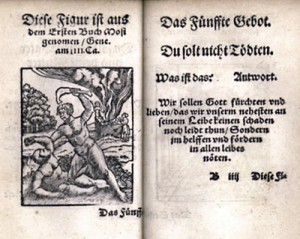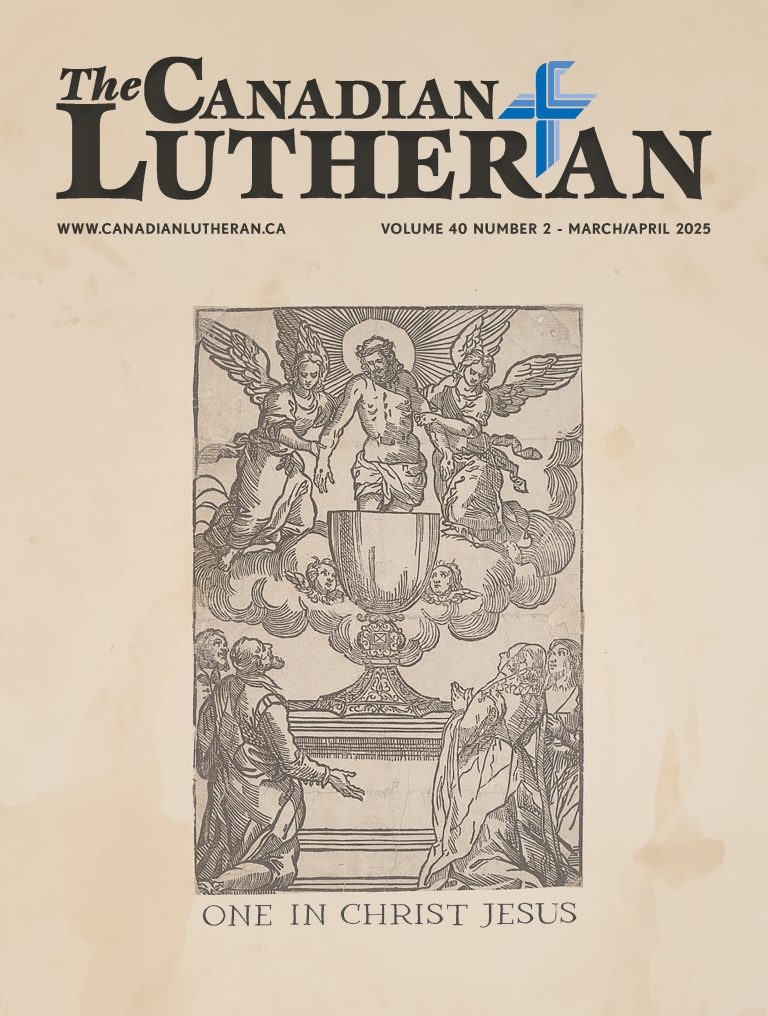In the beginnings
The prefaces to Luther’s Small and Large Catechisms have their own teachings
by Thomas A. Von Hagel
 One of the most significant concerns of the sixteenth century Lutheran Reformation was religious instruction in the parish. In his preface to the Small Catechism, Martin Luther bemoaned the sorry state of affairs in his day:
One of the most significant concerns of the sixteenth century Lutheran Reformation was religious instruction in the parish. In his preface to the Small Catechism, Martin Luther bemoaned the sorry state of affairs in his day:
“How pitiable, so help me God, were the things I saw: the common man, especially in the villages, knows practically nothing of Christian doctrine, and many of the pastors are almost entirely incompetent and unable to teach. Yet all the people are supposed to be Christians, have been baptized, and receive the Holy Sacrament even though they do not know the Lord’s Prayer, the Creed, or the Ten Commandments, and live like poor animals of the barnyard and pig pen.”
According to Luther, the teachers of the church were not instructing the people of the church in the doctrines of the church. To Luther’s great dismay, the people of the church were terribly unlearned in spiritual matters. This would be rectified by producing an instructional booklet on the most basic doctrines of Christianity (catechism) and religious instruction (catechesis).
After aborted attempts by Justus Jonas, John Agricola, and Philip Melanchthon to produce a catechism, Luther took this task upon himself. In 1528 and the following year, he preached three series of sermons on the Ten Commandments, the Lord’s Prayer, the Apostles’ Creed, Baptism, and the Lord’s Supper. These became the subjects of the chief parts of his two catechisms. (Confession and Absolution also made their way into the catechisms.)
In 1529, his Small Catechism and Large Catechism were both published. The purpose of the former was to teach the child, the latter the adult.
Luther’s two catechisms are classics of western Christianity and among the confessional writings in Lutheranism, and yet, their value is even greater. From Luther’s day until now, they have both informed and formed numerous generations of Lutherans through their use in catechizing youth, converts, and adults in the basic doctrines of Christianity. We won’t analyze the ‘what’ of these catechisms here, but instead look at the prefaces—one for the Small Catechism and two for the Large Catechism. In these prefaces Luther introduces the catechisms by providing significant reasons why they should be taught and suggesting helpful and practical advice for teaching.
The Preface to the Small Catechism
In the Preface to the Small Catechism, Luther reminds pastors of their vital responsibility to teach their people. He was speaking to the pastors of his day and ours and gives practical advice for this instruction. Luther warns, “avoid, …various texts and forms.” This is so the young can better learn and memorize the words of the catechism. Luther also suggests order and patience. Not until after the First Commandment is taught and learned is the second undertaken, lest the student is overwhelmed and learns nothing. In addition, after the pastor has taught the Small Catechism to his people so they understand it, he should lead them to the Large Catechism so they might learn more concerning the Christian faith.
Finally, the pastor must instruct his people to see their great need to receive the Sacrament of the Altar which “gives them help against … evils and bestows so much goodness.” Catechesis has a purpose: it leads people from their sin to God’s salvation offered in the Sacraments.
In this preface, Luther shows himself as the consummate pastor and teacher. The Small Catechism is not an academic “club” to “beat” information into people, but rather, it is a tool and a guide, directing people to their loving Lord.
The Longer Preface to the Large Catechism
The longer preface to Martin Luther’s Large Catechism establishes the central role of the catechism in the life of the people and pastors. This preface mentions the Ten Commandments, the Apostles’ Creed, and the Lord’s Prayer in passing, but does not analyze or summarize the five (or six if you count A Brief Exhortation to Confession) chief parts of the Large Catechism. Instead, it powerfully exhorts pastors and preachers to utilize extensively the catechism.
First, the catechism needs to be studied thoroughly by all pastors. Luther suggests that pastors who neither study nor teach the doctrines of the catechism “would make better swineherds or dog keepers than spiritual guides and pastors.”
Second, the catechism needs to be studied thoroughly because of the great depth of its content.
Moreover, Luther, the author of the Large Catechism, acknowledges, “I must still read and study the catechism daily, yet I cannot master it as I wish, but must remain a child and pupil of the Catechism, and I do it gladly.”
Third, Luther’s educational approach is superb. He not only exhorts pastors what to do—thoroughly study the catechism—but how to do it: frequently and in different fashions. The Christian cannot learn the catechism by reading through it once or even occasionally. Instead, if the catechism is to become part of your life, then it must be in your eyes and ears and mouth and mind and life.
In summary, Luther notes the lifelong role of the catechism.
The head of the household has responsibility to teach his family the basic doctrines of the Christian faith
The Shorter Preface to the Large Catechism
The shorter preface to Martin Luther’s Large Catechism also addresses a number of ‘whys’ and ‘hows’ of catechesis in its few pages.
First, there are the ‘whys.’ It is the head of the household’s responsibility to teach his family and servants the basic doctrines of the Christian faith so they understand them. He must examine them and should not tolerate those who refuse to learn. Those being taught are responsible to learn the more elementary portion of the Christian faith which includes the Ten Commandments, the Apostles’ Creed, and the Lord’s Prayer. These three have always been the basis of the church’s catechesis beginning with her earliest days. The more learned portion of the Christian faith consists of “Baptism and the holy Body and Blood of Christ.” According to Luther:
“Whoever does not possess [the knowledge of the catechism] should not be reckoned among Christians nor admitted to a sacrament, just as a craftsman who does not know the rules and practices of his craft is rejected and considered incompetent. For this reason young people should be thoroughly instructed in the various parts of the Catechism or children’s sermons and diligently drilled in their practice.”
Both the head of the household and the household have respective responsibilities in regard to catechesis.
Second, there are a few ‘hows.’ Luther states that you should “require young people to recite [the catechism] word for word” and they should hear regularly sermons on the catechism. In addition, doctrines should be taught in conjunction with corresponding Psalms and hymns.
Among the many hymns Martin Luther penned, Lutheran Service Book includes six which directly correspond to the six chief parts of the catechism:
- Ten Commandments — “These are the holy Ten Commands” (#581)
- Apostles’ Creed — “We All Believe in One True God, Maker” (#953)
- Lord’s Prayer — “Our Father, Who from Heaven Above” (#766)
- Baptism — “To Jordan Came the Christ, Our Lord” (#406)
- Confession and Absolution — “From Depths of Woe I Cry to You” (#607)
- Lord’s Supper — “O Lord, We Praise You” (#617)
Luther understood that teaching the Christian faith in the parish is a matter of utmost importance. It is so important it should permeate the life of the Christian in studies, hearing sermons, and the singing of Psalms and hymns.
Conclusion
While it is good that the catechisms are still known and often used in contemporary Lutheranism, we should not pass over their prefaces hastily in getting to the six chief parts. These brief introductions continue to provide a wealth of teaching insights concerning the ‘whys’ and ‘hows’ for catechesis in our Lutheran church today. They remind both pastor and people of their complementary responsibilities: teaching and learning the most basic doctrines of the Christianity so that all know God’s will according to the Ten Commandments; so that all can confess the Apostles’ Creed and pray the Lord’s Prayer; so that all know the gracious and divine benefits received in the sacraments.
Luther also suggests practical methods of instruction: repetition and memorization, patience and orderliness, the subject of preaching and singing.
Learning the catechisms is not an end in itself. They teach the Word of God which comforts and protects against all evils. And they lead the Christian to God’s grace which is offered in the sacraments. Not only are the prefaces part of the confessional writings of the Lutheran Church, but they provide noteworthy ‘whys’ which bolster the value of these catechisms in religious education and ‘hows’ which supply practical advice for teaching the basic doctrines of Christianity.
Dr. Thomas A. Von Hagel is professor of Theology at Concordia University, Chicago. He teaches courses in historical theology such as Patristics, Martin Luther and Women in Christianity. This article is adapted from an essay published in Word&Deed, Fall 2001.




